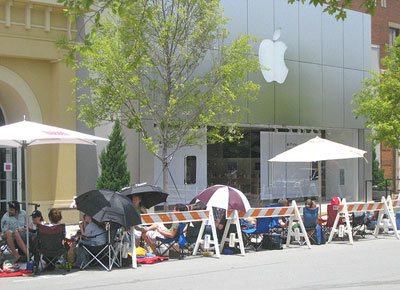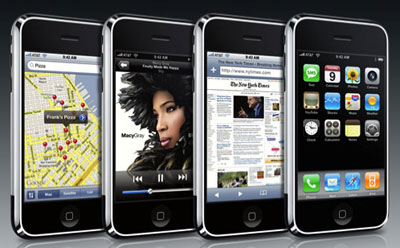 During the last month — or the last seven months, really — I’ve been wondering: Is the iPhone the most emotional product of all time?
During the last month — or the last seven months, really — I’ve been wondering: Is the iPhone the most emotional product of all time?
Think about it. Forget the Apple-is-or-is-not-making-a-phone speculation that circulated on the Internet before Steve Jobs introduced the iPhone in January 2007. Since then, conjecture hit a boil quickly and has been bubbling ever since, reaching a fevered pitch with traditional media, bloggers, Apple lovers, Apple haters, Treo/Blackberry/Nokia cell phone users, even bystanders on street corners, offering spirited opinions before it was for sale.

When the iPhone was released on June 29, the frenzy didn’t die down, it just headed in new directions — real reviews; in-depth analysis, lists of likes/dislikes; what the iPhone was missing; where Apple went wrong; comparisons with smart phones; tips and tricks; hacks; “app” lists; and the ever-present “bug” report.
After spending years in product design and development, having worked on a number of cell phone projects, and having used nearly every handheld device known to man (Sharp Zaurus, Philips Nino, Cassio Cassiopeia, HP iPAQ, Palm, Handspring, smart phones, and the Blackberry, to name a few), I must say the iPhone impressed me in ways I hadn’t anticipated.
Aside from the sexy industrial design, the beautiful user interface, and overall ease of use, what intrigues me is the mindset of Apple and the iPhone itself. It’s clearly a consumer device intended for consumer use. That means it does what average people need, not necessarily what business professionals, IT folks, and tech geeks want it to do.
It’s as if Apple “dumbed down” the iPhone on purpose, choosing to do things a certain (less complicated) way even though the technology exists to do these things in a more complete (albeit complicated) fashion. One cannot edit a Word document or spreadsheet on the iPhone like they can on a smart phone. Or cut and paste between email and notes. Or hyper-organize oneself with calendar, email, or contact programs.
By design?
It’s refreshing to me, maddening for others, that Apple appears to be avoiding “feature creep”, the product development phenomenon when engineers and marketing folks insist on adding to a device features and functions “because they can” and because they think consumers want them. In cell phone projects dating back to the mid 1990s, researchers found that average consumers were only using a small part of the feature set of their phones — making a call, using the address book, and trying to figure out how to change ring tones. The same is true today.
By “limiting” the iPhone, Apple focuses attention on the relationship between the human as average user, the phone, and the primary information device in people’s lives today — the computer. The computer does the heavy lifting, the iPhone is there to retrieve, read, and add short bursts of information when one is mobile. Not everybody needs all of what can be done using a Windows Mobile smart phone, a Palm Treo, a Nokia, or a Blackberry. Not everybody needs GPS, telnet capabilities, or video recording.
Apple also surprised me by developing a convergence device, and I hate convergence devices because I feel they do one thing really well but other things poorly, so why bother? Developing a successful convergence device has been consumer electronic design for more than 15 years, as cameras appeared in phones, cameras were in personal digital assistants (PDAs), phones were added to PDAs, and music and television collided with all sorts of devices. Only now do we see technology ready to deliver true convergence at the handheld level, depending on the manufacturer.

Apple’s convergence focuses on three areas: communications, information, and entertainment, and the iPhone delivers much better than I had anticipated. The iPhone obviously communicates via the phone, SMS, email, and social networks with Web 2.0 “apps”. It delivers information such as calendar, contacts, email, maps, stocks, and weather through the device and the Safari web browser. And its iPod features entertain even better than previous iPods due to the larger display and five generations of refinement.
This hit me when I wasn’t looking. After I walked the dog one afternoon I sat down to cool off. I started playing a White Stripes song, switched over to read an SMS I had received, read my email (three accounts), and jumped on the web for a few minutes, all seamlessly, all without realizing it, and with the music playing the whole time. I’m not sure about the Nokia phones people are raving about (the N95 in particular), but I did not enjoy this kind of satisfaction just reading email or hopping on the Web using a Blackberry.
Yet the iPhone is far from perfect, and this is what gets everybody’s emotional juice flowing. The device suffers from many flaws, one of which may be that the mindset of Apple and the iPhone is skewed too much to one side. Or that, to some, it actually falls short as a true convergence device. Even so, it’s discussions like these over the past month that make me wonder if the iPhone isn’t the most emotional product of all time.
Tomorrow we take a deeper look at the iPhone, from the purchase/buying experience to using the phone’s communications, information, and entertainment features.

Interesting analysis. Most emotional, I can’t say, but most overrated by the blogging/media population is sure: http://www.reuters.com/article/technologyNews/idUSN2442534920070724
I don’t know if the average person would consider buying such a thing.
Alexis is right most people don’t buy “smart phones”.
But considering that the iPhone is CHEAPER than other “smart phones” with a two-year contract, its a great opportunity to get into the cutting edge of mobile technologies. Its less expensive than the BlackBerry or the Motorola Q with a service contract.
Mobile Price Comparisons with Service Plans
People are getting really worked up about the iphone, anything so cool is going to cause a lot of stir. What I’m disappointed in is the battery life, considering how expensive the thing is you would think the battery would last longer. I found ipodjuice.com though, they have a service to get your iPhone battery replaced that costs less than apple’s. Glad to know there are options to that $85 that apple charges.
I like this blog it’s a master piece! Glad I discovered this on google.
If you would like to increase your experience simply keep visiting this web site and be updated with the hottest gossip posted
here.
Selain desain industri yang seksi, antarmuka pengguna yang indah, dan kemudahan penggunaan secara keseluruhan, yang membuat saya penasaran adalah pola pikir Apple dan iPhone itu sendiri. Ini jelas perangkat konsumen yang ditujukan untuk penggunaan konsumen. Itu berarti melakukan apa yang rata-rata orang butuhkan slot deposit pulsa, belum tentu apa yang diinginkan oleh para profesional bisnis, orang IT, dan pakar teknologi.